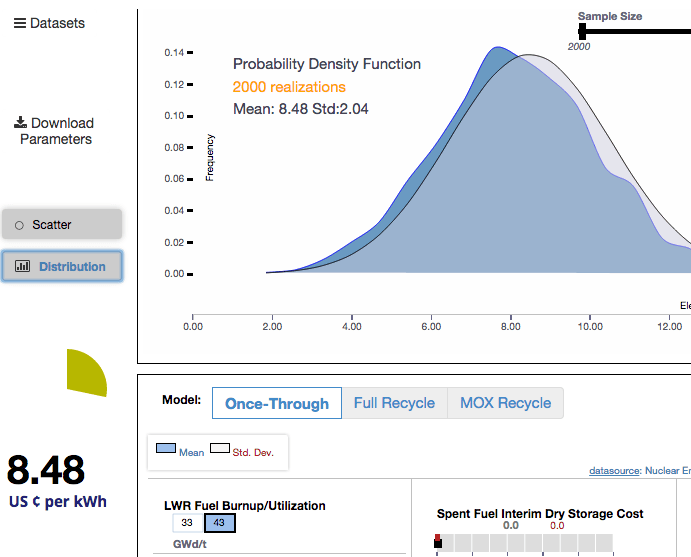Introducing the Nuclear Fuel Cycle Cost Calculator
By John Mecklin | May 31, 2015

China has dozens of nuclear power plants under construction and in the planning stages. India is planning its own massive expansion of nuclear generation capacity. Countries across the Middle East—from Saudi Arabia and the Gulf emirates to Tunisia and Jordan—are seriously considering the creation of nuclear power sectors. And as countries around the world make policy decisions about nuclear technology, they will also be making choices about nuclear fuel cycles and whether to reprocess spent nuclear fuel, separating out uranium and plutonium for reuse. These decisions will have major implications for international security. If the growth of nuclear power is accompanied by increased reprocessing, new stores of plutonium will be created around the world, increasing the chances that terrorists or governments could steal or divert it to make nuclear bombs.
Over the last two years, the Bulletin of the Atomic Scientists and the University of Chicago have created an online tool that will help countries understand the true cost of choosing the reprocessing route—and perhaps also help limit the spread of nuclear reprocessing. The Nuclear Fuel Cycle Cost Calculator estimates the full cost of electricity produced by three configurations of the nuclear fuel cycle. This calculator is the first generally accessible model to provide a nuanced look at the economic costs of nuclear power, particularly in regard to the reprocessing of spent nuclear fuel. Among many other things, the calculator clearly demonstrates that in most cases, reprocessing results in electricity that is considerably more expensive than other nuclear power, when all costs are added in.
The Nuclear Fuel Cycle Cost Calculator estimates the price of electric power produced in:
- The once-through fuel cycle used in most US nuclear power plants, in which uranium fuel is used once and then stored for later disposal.
- A limited-recycle mode in which a mix of uranium and plutonium (that is, mixed oxide, or MOX) is used to fuel a light water reactor.
- A full-recycle system, which uses a fast neutron spectrum reactor that can be configured to “breed” plutonium that can subsequently be used as either nuclear fuel or weapons material.
The calculator lets users test how sensitive the price of electricity is to a full range of components—more than 60 parameters that can be adjusted for the three configurations of the nuclear fuel cycle considered by this tool. Users can select the fuel cycle they would like to examine, change cost estimates for each component of that cycle, and even choose uncertainty ranges for the cost of particular components. This approach allows users around the world to compare the cost of different nuclear power approaches in a sophisticated way, while taking account of prices relevant to their own countries or regions.
Despite the economic and proliferation arguments against the reprocessing of spent nuclear fuel, many nuclear-capable countries continue to engage in the practice, creating stocks of separated plutonium and uranium that can be used to fuel nuclear power plants—or, in the case of plutonium, to build nuclear bombs. (Plutonium emits relatively little ionizing radiation and is smaller in volume than spent fuel, making it an attractive theft target, compared to other sources of fissile material.)
Over the past 30 years, the United States has tried to persuade other countries—France, Russia, United Kingdom, India, and Japan, most notably—to stop their reprocessing operations, but without success. US arguments have focused on the dangers of nuclear weapons proliferation as a major reason for countries to suspend or resist reprocessing. These arguments often fall on deaf ears in other countries, because the United States has contributed substantially over the past 60 years to the development and proliferation of nuclear technologies and weapons based on highly enriched uranium and plutonium. United States officials and even independent US scientists who argue for reduced proliferation are often unconvincing to countries more recently involved in the nuclear power project.
If proliferation concerns do not persuade other countries to eschew reprocessing, however, those countries may respond to factual data about the financial burden of reprocessing, in comparison to once-through use and storage of nuclear fuel.
Differences in construction, fuel, borrowing, and operation and maintenance pricing make the actual costs of different fuel cycles in each country very difficult to calculate for policy makers who are not also nuclear scientists. Often, the overall cost of a particular approach to nuclear power generation can be nearly impossible to evaluate, because vendors of nuclear technology consider some of the information required for such an evaluation to be proprietary. Furthermore, pricing and cost calculations may change dramatically over time in the dynamic global nuclear power industry. It can be challenging even for well-meaning governments to project and discuss the costs of nuclear power in a transparent and meaningful way. The Nuclear Fuel Cycle Cost Calculator addresses this problem.
The Nuclear Fuel Cycle Cost Calculator is based on an economic model developed by University of Chicago professor (and Bulletin Science and Security Board member) Robert Rosner, with assistance from former colleagues at Argonne National Laboratory. Rosner partnered with two University of Chicago research assistants, Sam Olofin and Jeremy Klavans, to translate his initial model, optimizing its computer code so it could instantaneously display results over the Web. Experts from Princeton University's Program on Science and Global Security provided feedback on these efforts, and Bulletin staff helped Rosner's team work through several different iterations of the cost calculator, aiming to make it accessible and valuable to nuclear power experts, to governmental leaders, to advocates involved in nuclear power decisions, and to ordinary citizens. The project was supported by significant funding from the MacArthur Foundation.
In coming weeks and months, nuclear power experts from around the world will be invited to give their assessments of the Nuclear Fuel Cycle Cost Calculator. Those comments will be published below this introduction and will inform the Bulletin's efforts to improve this interactive tool over time.
Together, we make the world safer.
The Bulletin elevates expert voices above the noise. But as an independent nonprofit organization, our operations depend on the support of readers like you. Help us continue to deliver quality journalism that holds leaders accountable. Your support of our work at any level is important. In return, we promise our coverage will be understandable, influential, vigilant, solution-oriented, and fair-minded. Together we can make a difference.














